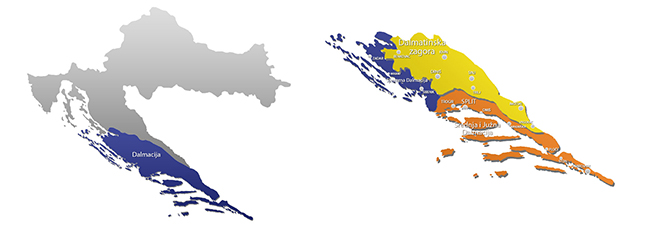[image]
[/image]
This brief review of the history of viticulture and winemaking of Dalmatia serves to acquaint you with the wine treasures of this beautiful region where one magical story of the wine industry in Croatia started!
Dalmatia is divided into three sub-regions: North Dalmatia, Central and South Dalmatia and the Dalmatian hinterland. In northern Dalmatia, with the exception of the Primošten vineyards, the vineyards are distanced from the coast, so here the wines are fresher and livelier than in the southern Dalmatia, without having the characteristics of the continental climate, which in turn can be found in the Dalmatian hinterland. Central and Southern Dalmatia is a typical Mediterranean region and almost all the varieties found there are authentic.
Because of centuries of adapting to the climate and soil, the best results are on the sunny slopes facing the sea. The Dalmatian hinterland has historically been oriented towards the continental area and most of the trade took place locally or was directed toward today’s Bosnia and Herzegovina. Coastal Dalmatia in turn shipped their wine throughout Europe. For these reasons, the stylish and assortment of these the three regions are very different.
Because of centuries of adapting to the climate and soil, the best results are on the sunny slopes facing the sea. The Dalmatian hinterland has historically been oriented towards the continental area and most of the trade took place locally or was directed toward today’s Bosnia and Herzegovina. Coastal Dalmatia in turn shipped their wine throughout Europe. For these reasons, the stylish and assortment of these the three regions are very different.
In the hinterland of Dalmatia, with an emphasis on Imotsko polje, the white indigenous variety kujunđuša predominates, whose mild gentle and wines have a share of up to 90 percent in the total production. The coastal belt is a place where the black Plavac Mali, Babic and recently Crljenak have the greatest success. White varieties have found their home on the island Korčula where some of the best white Croatian wines come from. Among them, the most notable is Pošip.
[image]

[/image]
JUŽNA DALMACIJA
TIPIČNI PREDSTAVNIK CRNIH SORTI
[list line=”no” style=”style6″]
- plavac mali
[/list]
TIPIČNI PREDSTAVNICI BIJELIH SORTI
[list line=”no” style=”style6″]
- pošip
- grk
- malvasija dubrovačka
- maraština ili rukatac
[/list]
SREDNJA DALMACIJA
TIPIČNI PREDSTAVNIK CRNIH SORTI
[list line=”no” style=”style6″]
- plavac mali
[/list]
TIPIČNI PREDSTAVNIK BIJELIH SORTI
[list line=”no” style=”style6″]
- vugava
[/list]
SJEVERNA DALMACIJA
TIPIČNI PREDSTAVNICI CRNIH SORTI
[list line=”no” style=”style6″]
- babić
- syrah
- grenache
- plavina
[/list]
TIPIČNI PREDSTAVNICI BIJELIH SORTI
[list line=”no” style=”style6″]
- debit
- maraština
[/list]
DALMATINSKA ZAGORA
TIPIČNI PREDSTAVNIK BIJELE SORTE
[list line=”no” style=”style6″]
- kujundžuša
[/list]
TIPIČNI PREDTSAVNIK CRNE SORTE
[list line=”no” style=”style6″]
- trnjak
- merlot
[/list]
The most charming wine event in this region.
[list line=”no” style=”style4″]
[/list]
Source: S. Špiranec, Vina Hrvatske – riznica raznolikosti, Hrvatska gospodarska komora, Zagreb, 2011.
